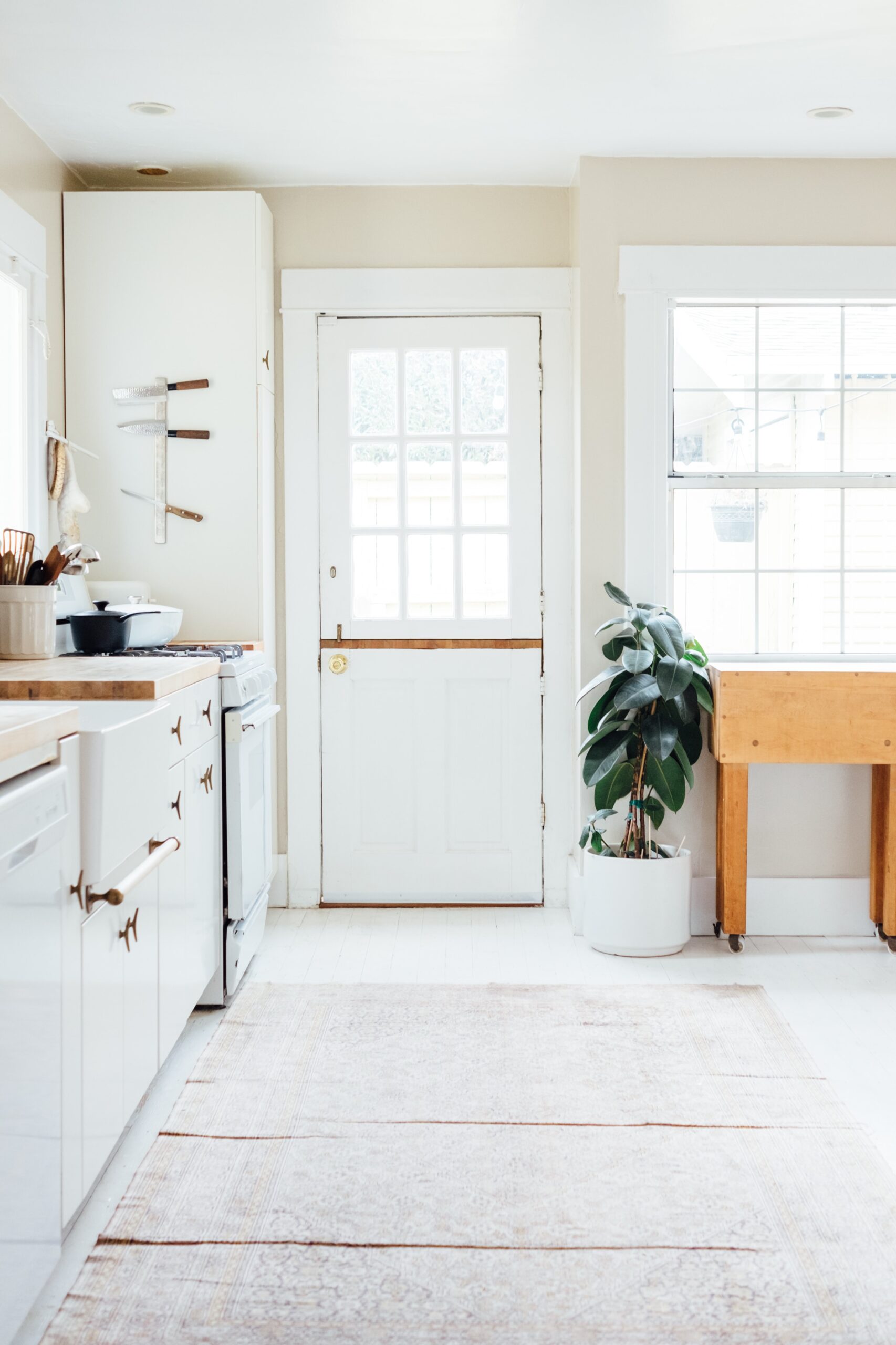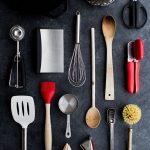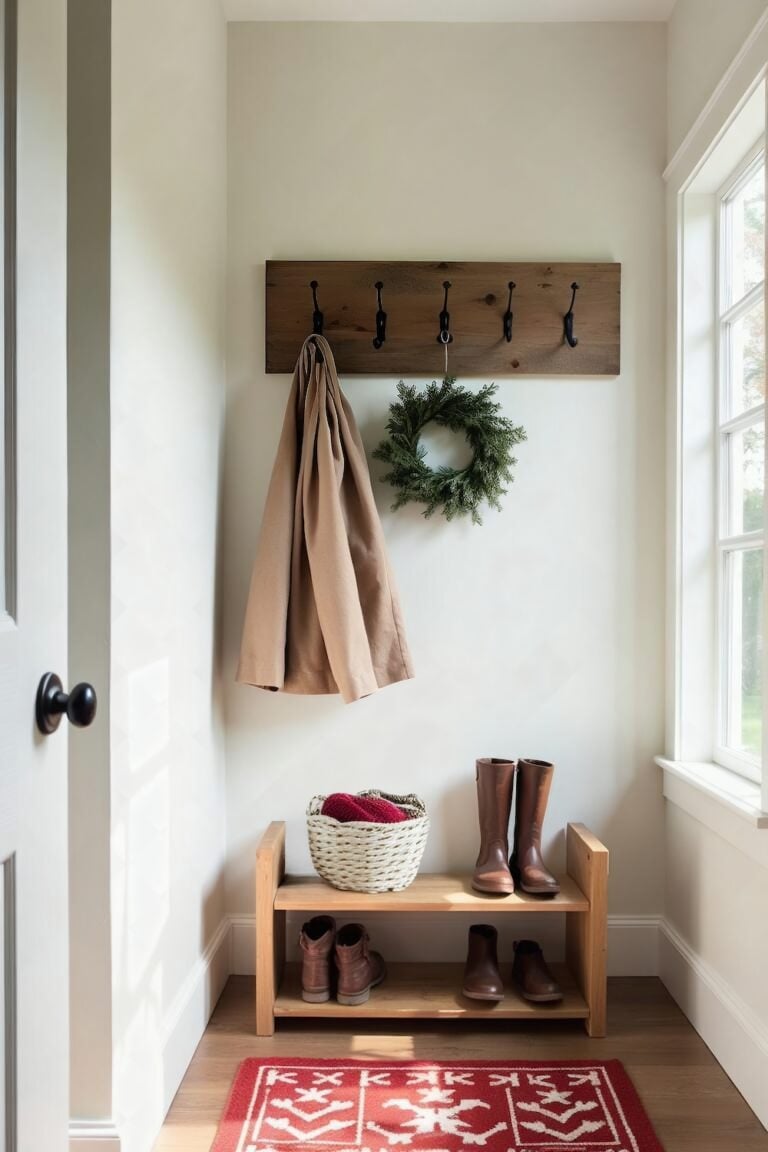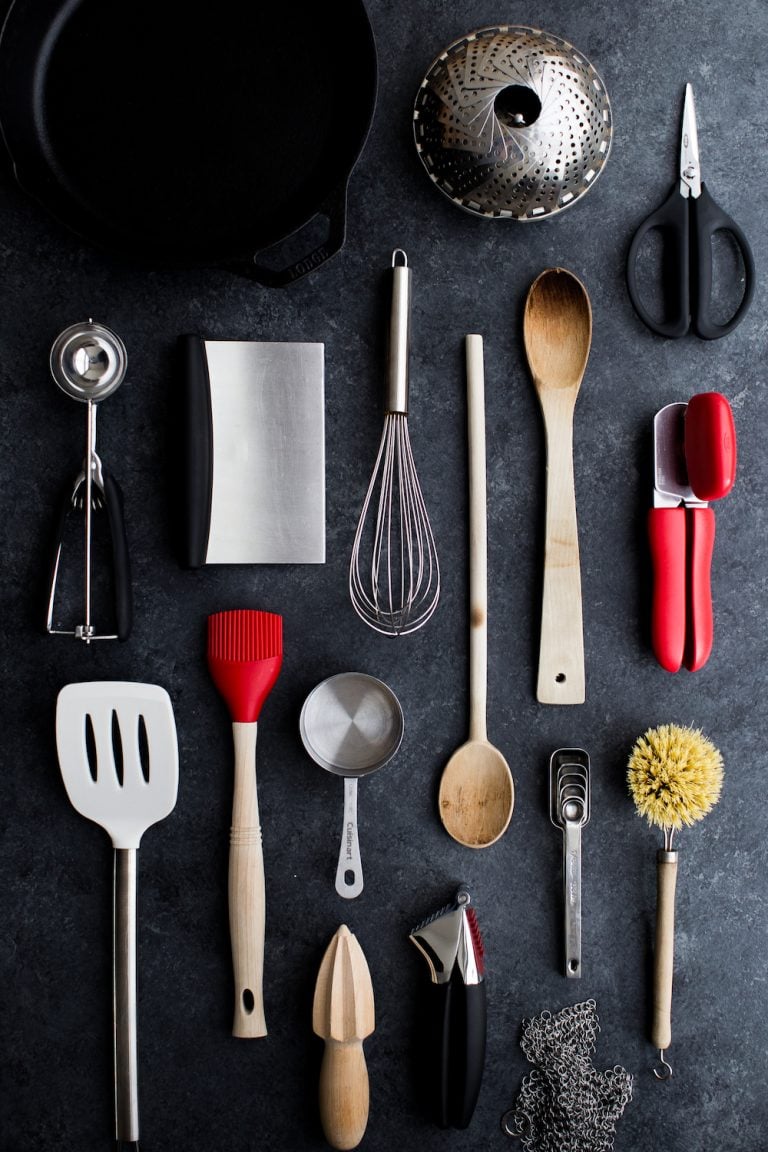How to Declutter Your Kitchen
Are you overwhelmed by your cluttered kitchen? If you’re ready to simplify and create a kitchen you love, this guide will teach you how to declutter your kitchen in an easy and approachable way.
As a busy mom, dietitian, and food content creator, I spend a lot of time in the kitchen. From developing and photographing recipes for clients to preparing meals for my own family, the kitchen is the most used space in our home.
Over the years, I’ve realized that a simplified, organized kitchen is not only easier to maintain, it genuinely makes cooking more enjoyable and improves how our household runs.
That’s not to say my kitchen is always spotless and perfectly organized. It can feel quite the opposite some days! But over the years, I’ve learned how to simplify and streamline this space and have experienced the benefits of having a minimalist kitchen.
In this guide, I’ll teach you how to declutter your kitchen in an approachable way. I’ll also share my tried-and-true tips for tackling tricky areas like countertops, cabinets, and your pantry, and how to maintain a simplified kitchen moving forward.
Before I dive in, here’s what this guide will cover:
The importance of a clutter-free kitchen
Decluttering your kitchen has several benefits, some extending beyond the space itself. Here are some of the benefits you can expect from having a decluttered kitchen.
- A kitchen that is easier to clean and maintain. This cleanliness reduces the risk of cross-contamination and ensures that your kitchen remains a safe space for preparing food.
- Easier and more efficient meal planning. You’ll be able to quickly find what you need and be more efficient with your time. A clutter-free kitchen makes it easier to see what you have available, allowing you to make quicker and more informed choices when it comes to meal planning and grocery shopping.
- Faster food prep. You can focus more effectively when your kitchen is uncluttered and thoughtfully organized. This increased focus increases productivity, efficiency, and a more enjoyable cooking experience.
- More peaceful and enjoyable cooking environment. This positive energy can inspire you to try new recipes, experiment with different ingredients, or even learn to love cooking.
- Financial savings. Decluttering your kitchen can help you save money by reducing food waste, as you’ll know exactly what you have on hand and are less likely to buy duplicates.
- A calming command center. For many of us, the kitchen is much more than a place to prepare and eat meals. It’s the heart of the home, your household’s command center, and a place where lasting memories are made. When your space is free of clutter, it creates a more organized and calming atmosphere that can benefit your stress levels and the flow of your day.
How to Declutter Your Kitchen:
A Step-by-Step Guide
Step 1: Assess your kitchen clutter
The first step in decluttering your kitchen is to assess your current space.
Take a good look around your kitchen and mentally note the areas that are particularly cluttered or disorganized. Doing this will allow you to identify your biggest problem areas and form a picture of the changes you want to make.
Here are some questions to ask yourself
- What are the main types of clutter in your kitchen? These are the things you’ll want to find a solution for. For example, if you have a lot of paper clutter on your countertops, you’ll want to create a system to keep papers from piling up in the future.
- What areas are not being used to their full potential? Come up with some ideas for how you could better use the space in your kitchen once you’ve decluttered.
- Can things be moved to improve your organization and efficiency in the kitchen?
Step 2: Plan & prepare
Now that you’ve assessed your kitchen clutter, it’s time to make a plan. A checklist will make this big project much more approachable while keeping you on task and giving you a sense of accomplishment every time you check something off.
You can make your own checklist or grab a printable copy of mine by adding your name and email below!
Sample Kitchen Declutter Checklist
Countertops
- Paper piles
- Things that don’t belong
- Decor
- Cookbooks
- Small Appliances
Cabinets, drawers & shelves
- Small appliances
- Water bottles
- Food storage containers
- Cooking tools & utensils
- Mixing bowls & measuring cups
- Cups, glasses & coffee mugs
- Plates & bowls
- Pots & pans
- Bakeware (baking sheets, pans, etc.)
- Cutlery & cutting boards
- Linens & pot holders
- Cleaning supplies
- Cookbooks
- Junk drawer
Pantry (dry food storage)
- Baking (flour, baking powder/soda, cocoa powder, etc.)
- Sweeteners (honey, sugar, etc.)
- Breakfast items (cereals, bagels, oatmeal)
- Nut butters & spreads
- Bread & wraps
- Grains & dried beans
- Pasta
- Snacks (chips, bars, etc.)
- Desserts
- Dried fruit, nuts, & seeds
- Soups & broths
- Canned beans & fish
- Canned vegetables
- Canned tomatoes & pasta sauce
- Cuisine-specific (Asian, Mexican, etc.)
- Spices
- Cooking oils
- Tea & coffee
- Beverages
- Extra condiments
- Paper goods
- Special occasion (frosting, sprinkles, cake mixes, candles, etc.)
Cold food
- Refrigerator
- Freezer
Now that you’ve got a plan, all that’s left to do is gather a few supplies. Here are a few things you’ll need:
- An empty sink for rinsing containers and bins
- Empty boxes for donations
- Trash bags & recycling bins
- Hand vacuum for drawers, bins, and cabinets
- Cleaning spray or warm, soapy water
- Cleaning rags (damp and dry)
- Measuring tape for planning potential organization solutions
- Decluttering checklist to stay motivated and on track
Questions to help you declutter
As you go through your items, ask yourself these questions to gain clarity around what items you can comfortably let go of versus what things you should keep. You can also cross-reference this handy minimalist kitchen essentials checklist I created to see what you might need or not need!
- When was the last time I used this?
- Does this item make my life significantly easier in the kitchen?
- Do I have something else that can do the same thing?
- How many of these do I really need or use at one time?
- Am I holding onto this “just in case” or for sentimental reasons?
- Is this something I could borrow from a friend, family member, or neighbor if needed?
- Am I holding onto this “just in case” or for sentimental reasons?
- Is this something I care to clean and maintain?
- Would I buy this again today?
- If something is broken, when will I fix it?
Step 3: Declutter like a boss
Once you’ve printed your checklist, it’s time to get to work. I recommend starting with countertops. They’re not always easy, but clear counters immediately improve efficiency, create a more calming, enjoyable environment, and give you plenty of space to work as you declutter the rest of your kitchen!
Countertops
If your countertops are very cluttered, break the job into smaller segments, focusing on one zone or category of clutter at a time. For example, you could start by removing items from your counters that don’t belong in the kitchen and giving them a proper home elsewhere. Then you could declutter small appliances that are collecting dust, then paper piles, cookbooks, counter decor, and so on.
Tips for decluttering countertops
- Remove everything that doesn’t belong. Jackets, backpacks, keys, trash…
- Do a quick purge of paper piles. Sort your papers into one of three categories: keep, shred, or recycle. Toss what you don’t need and put papers you need to keep in a folder to take action on at another time.
- Put away small appliances. Only the ones you use daily should stay on your countertop. Donate those in good condition that you don’t need or use, and store the rest in a cabinet or pantry to free up valuable counter space.
- Get rid of countertop decor. Kitchens are messy. Spare yourself the unnecessary work of wiping food splatters off of picture frames and knick-knacks by moving these items elsewhere.
- Replace your dish drying rack. Dish towels are actually more hygienic, easier to clean, and take up far less space. Clean dishes also won’t pile up as much, and you’ll have all that countertop space to use once dry items are put away.
- Give everything a home. This applies to items that belong in the kitchen and those that belong elsewhere. Ensuring that everything has its own spot is the easiest way to maintain a tidy and clutter-free kitchen.
- Consider what you can subtract. What things can you take off of your counters and move to a less visible location? Cookbooks and canisters may look nice, but they take up usable space and need to be cleaned more frequently if left on your countertops. If there are items you don’t use on a daily basis, move them to a shelf, cabinet, or into the pantry.
- Look into space-saving solutions. This might include shelving for cookbooks, wall-mounted files for important papers, hooks for your most-used kitchen tools, and a magnetic strip or drawer organizer for knives. These items will help keep kitchen counters clear and your most important items easily accessible.
Cabinets & drawers
Once the countertops are clear, I like to move onto the cabinets and drawers. Start with some easy categories, like water bottles, kitchen utensils, and food storage containers. If you don’t have a pantry, ignore those cabinets for now. A little decluttering in these areas can help create momentum that will keep you motivated.
Tips for decluttering kitchen cabinets and drawers
Cabinets and drawers can quickly become cluttered without regular purging and proper organization. Here’s how to clear out the clutter and establish order in your cabinets and drawers.
- Tackle one category at a time. Pull everything out and sort items so you can easily see what you have.
- Clean shelves, drawers, and storage bins. Give these a quick vacuum and wipe-down so they are clean and dry when you put items back. If you plan to add organizers or bins, measure your cabinet and drawers before putting items back so you know what dimensions to look for.
- Decide what to donate, toss, or keep. Toss or recycle broken or mismatched items, like old Tupperware or water bottles with missing tops. Donate duplicate items, things you no longer use or need, and single-use tools that another tool can easily do (e.g., avocado slicers, meat shredding claws, omelet maker). Be ruthless and realistic here. How many coffee mugs, pot holders, and water bottles do you really need?
- Consider new organization options. Things like drawer dividers, bins, labels, and cabinet organizers help keep items organized. These are particularly helpful for small items like spices and baking supplies, and clunkier items like lids.
- Keep like items together. When you put things back, keep similar items together. For example, keep all of your bakeware in one cabinet or drawer and all of your frequently used cooking utensils in the same drawer or canister.
Pantry (dry food)
A cluttered pantry can make it difficult to find what you need, which leads to wasted food, time, and money. Here are some tips to help you declutter your pantry like a boss.
Pantry decluttering tips
- Give yourself plenty of time. Decluttering a full pantry can take a single person upwards of 6-8 hours to complete, and that’s without shopping for and installing new storage solutions. If you want to declutter your pantry in one go, consider enlisting some help. You can also tackle 1-2 categories or shelves at a time and complete it over the course of a few days or a week. Yes, it may require more digging if your pantry is disorganized, but it will be much more manageable this way.
- Take everything out. Whether you’re doing the whole pantry or just one section, you’ll need to remove and sort what you’ve got.
- Clean empty shelves, bins, and drawers. Give everything a quick vacuum and wipe-down so they are clean and dry when you put items back.
- Go through your food. Consolidate duplicates, check expiration dates, and dispose of stale or expired foods. Make a donation box for unopened items you no longer want or need that a local food pantry, homeless shelter, or charity,
- Consider storage bins and organizers. I’m a huge fan of bins in the pantry for keeping categories contained and grouping like items together. Clear bins will make items easy to see, but I like these inexpensive white storage bins from IKEA and use them to organize our pantry foods into the categories listed on the decluttering checklist.
Cold food
Clearing out your fridge and freezer is a great way to wrap up your kitchen declutter because you know exactly what pantry foods you have and can create a quick meal plan to use up what you have as you work!
Refrigerator decluttering tips
- Check the expiration dates of all items. Dispose of any expired or spoiled food.
- Organize as you put foods back. Divide your fridge and freezer into zones (e.g., vegetables, fruits, dairy, meats) to keep similar items together. This will make it easier to find what you need and prevent clutter. Labeling containers with dates can help you keep track of freshness.
Step 4: Drop off donations
With the bulk of the decluttering done, you’ll want to find time in the next few days to drop off those donations. Don’t let those boxes linger —finish the job and get rid of your donations as soon as possible.
Where to donate kitchen items & food
Below is a list of places that may be able to use your unwanted kitchen items.
- Goodwill
- Salvation Army
- Big Brother Big Sister
- Habitat for Humanity Restore
- Vietnam Veterans of America
- A local thrift store
If you have unopened, non-expired food items, you can try donating them to a local food pantry, homeless shelter, soup kitchen, women’s shelter, or church. Just be sure to call before you make the trip since each organization will have specific guidelines around what they can and cannot accept.
Step 5: Optimize your organization
Once you’ve decluttered, optimizing how your kitchen is organized will further maximize your efficiency and make your decluttered kitchen easier to maintain. Here are some tips for organizing your newly decluttered kitchen.
Tips for organizing your kitchen after decluttering
- Keep things close to where you use them. For example, keep your most used cooking utensils in a drawer next to the stove, food storage containers in a drawer where you usually package up leftovers, and your coffee mugs in a cabinet close to the coffee pot.
- Maximize your drawer space. Drawer organizers for cutlery, utensils, spices, and knives can free up cabinet and counter space and keep drawers well organized. These inexpensive spice organizer strips make spices easy to see and keep them from rolling around.
- Make cabinets more user-friendly. Cabinets are notoriously tricky to keep organized and may even be tough to use if they’re very deep or high up. Things like pull-out shelves, lid organizers, lazy susans, and a spice rack shelf can make cabinets more functional and easier to maintain.
- Make use of free wall space. Consider things like a magnetic knife strip or hooks for frequently-used cooking utensils that might otherwise occupy valuable counter space. Hanging wall files are also great for keeping papers off the countertops but still easily accessible. Adding this IKEA magazine rack to our kitchen has been a total game-changer, as has our whiteboard, which I use for meal planning and to keep a running grocery list.
- Embrace bins. Pantry storage bins not only look nice, but they’re also incredibly useful for keeping foods organized by category. I have these from IKEA and think they’re great since they can be easily labeled (using printed labels or dry-erase markers) and are easy to clean. I’ve even tossed ours in the dishwasher on occasion —just avoid super hot water and the dryer setting. Clear food storage containers are also handy for things like dried fruit, nuts, seeds, and chocolate chips that easily spill or get lost in the pantry.
- Consider getting a label maker. This little tool has been huge in keeping our pantry shelves and bins organized, as well as the kids’ closets. I have this Nimbot label maker and use it for everything!
In addition, make a habit of regularly cleaning and wiping down your counters, cabinets, and drawers.
Tips for maintaining a clutter-free kitchen
Maintaining a clutter-free kitchen requires some organization and effort, but once you’ve decluttered, it’s totally doable. Here are some routines you can implement to keep your kitchen uncluttered and organized.
- Tidy your countertops daily. 5-10 minutes in the morning and again in the evening will keep clutter from accumulating.
- Don’t put things down; put them away. Make a habit of returning items where they belong when you’re done with them.
- Stop buying kitchen gadgets. Before you buy a new kitchen gadget, consider if it’s truly necessary or more of a marketing gimmick. Chances are you already own something that can give you the same result.
- Do regular mini-decluttering sessions. Notice a bin, drawer, or cabinet is getting out of control? Take a few minutes to refresh it. I find this easiest to do when drawers and shelves are least crowded—like when the dishwasher is full and before a big grocery shop.
- Say no to freebies. Free samples, water bottles, to-go condiments, and takeout cutlery quickly collect but rarely get used.
Following these tips will help you curb kitchen clutter and make your space easier to maintain.
Other minimalist & decluttering resources you might like
- Must-have minimalist kitchen essentials
- How to declutter toys (and keep it that way!)
- How to declutter kids’ books
Decluttering your kitchen may seem overwhelming at first, but with a clear plan and consistent effort, it is absolutely achievable. Following the steps I’ve outlined in this guide, you can transform your cluttered kitchen into a clean, efficient, and inviting space that inspires more culinary creativity, ease, and enjoyment.
So what are you waiting for? Put on your favorite music, grab your checklist, and create the kitchen you want to cook in. Happy decluttering!







